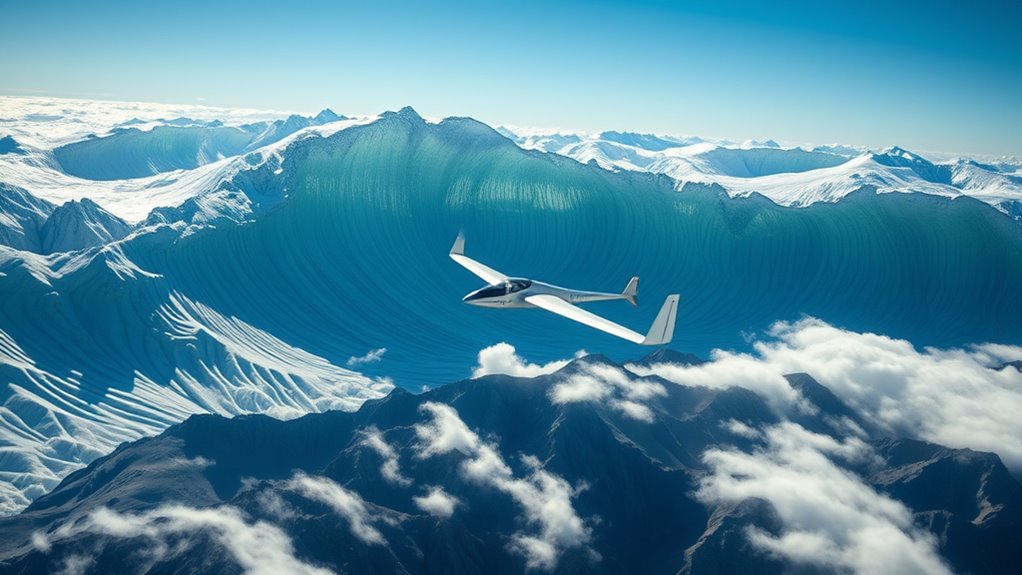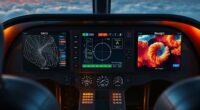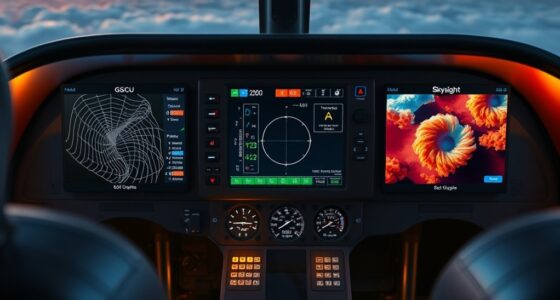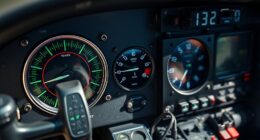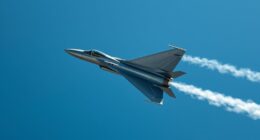Wave soaring works by harnessing atmospheric waves created by pressure differences and turbulence patterns. When you identify rising air caused by pressure drops and wave formations, you can use these invisible currents to climb to impressive heights, sometimes up to 30,000 feet. Recognizing signs like cloud patterns and wind shifts helps you find the strongest lift zones. Keep exploring; you’ll discover even more ways to master these natural energy sources and soar higher.
Key Takeaways
- Atmospheric pressure differences create vertical wave patterns that can lift gliders to high altitudes.
- Rising and sinking air pockets within these waves enable sustained altitude gains.
- Recognizing pressure signs like cloud formations and wind shifts guides pilots to lift zones.
- Turbulence patterns help identify stable rising air regions suitable for wave soaring.
- Mastering atmospheric dynamics allows gliders to reach heights up to 30,000 feet by harnessing natural wave energy.
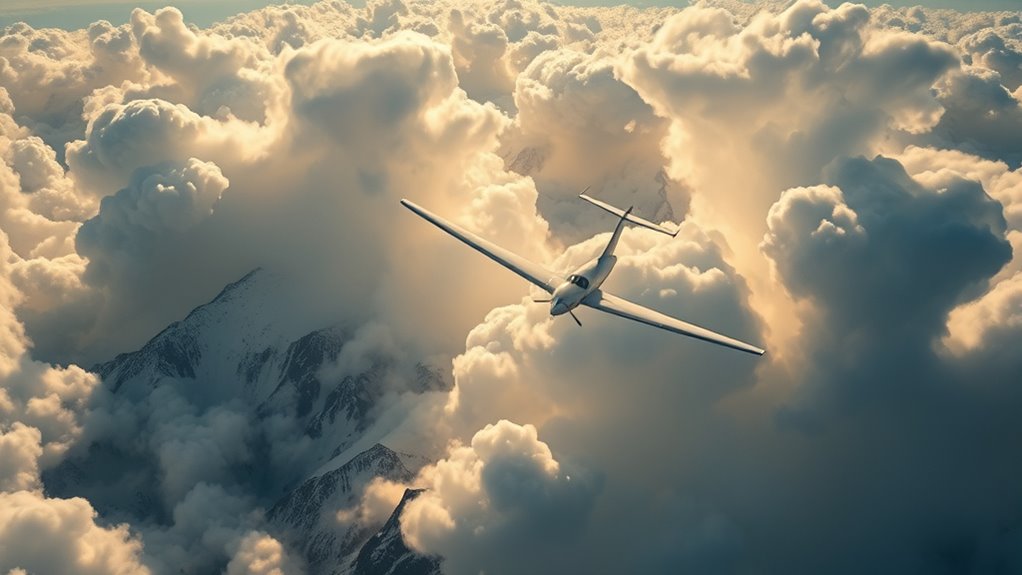
Have you ever wondered how glider pilots stay aloft for hours without engine power? It all comes down to understanding atmospheric waves and how they interact with the environment. One key factor is turbulence patterns, which are influenced heavily by variations in atmospheric pressure. When you’re soaring, you’re essentially riding on invisible waves in the air, created by differences in air pressure and temperature. These waves form when stable atmospheric conditions meet terrain or weather systems, generating zones of rising and sinking air that gliders can exploit. Recognizing these turbulence patterns allows pilots to anticipate where the lift will be strongest, helping them to stay aloft for extended periods. Additionally, understanding pressure differences enables pilots to better predict the formation and movement of these waves, optimizing their flight strategies.
Atmospheric pressure plays a critical role in wave soaring. When the air pressure drops at higher altitudes, it indicates that the air is less dense but often more stable. These pressure differences drive the formation of wave patterns that extend vertically into the stratosphere. As a glider enters these waves, it encounters a series of alternating rising and sinking air pockets. The key to sustained flight is to locate and follow these rising sections, which can lift a glider to astonishing heights—sometimes reaching 30,000 feet or more. The pilots who excel at wave soaring learn to read the signs of atmospheric pressure changes, such as cloud formations, wind shifts, and subtle air movements, to identify the best lift zones.
Understanding turbulence patterns is essential because they aren’t always obvious. Some turbulence is smooth and predictable, making it easier to ride the waves. Other turbulence can be more chaotic, caused by weather fronts or wind shear, which can disrupt the smooth flow of air and challenge even experienced pilots. By studying the way these turbulence patterns evolve with atmospheric pressure, glider pilots develop an intuition for where the lift will be strongest. This skill allows them to make strategic turns, optimize their altitude, and extend their flight duration.
In essence, wave soaring hinges on your ability to interpret the invisible forces at play in the sky. You need to recognize how atmospheric pressure differences create and sustain wave patterns. By doing so, you’re able to harness these natural air currents, riding them like a surfer on a wave. This delicate dance between turbulence patterns and pressure variations unlocks incredible heights and hours of flight time, demonstrating the remarkable power of understanding our atmosphere’s subtle dynamics.
Frequently Asked Questions
How Can Pilots Identify Suitable Wave Conditions in Real-Time?
You can identify suitable wave conditions in real-time by observing cloud patterns like lenticular clouds, which indicate strong atmospheric waves. Keep an eye on temperature gradients; sharp changes suggest wave activity. Use your instruments and visual cues to spot these signs, and listen for pilot reports or weather updates. Recognizing these indicators helps you locate the best wave lift, ensuring a safe and efficient soaring experience.
What Safety Precautions Are Essential During High-Altitude Wave Soaring?
When soaring high on atmospheric waves, you need to prioritize safety. Always carry emergency preparedness gear like radios, first aid kits, and survival equipment. Regularly check your equipment safety, ensuring harnesses, instruments, and communication devices work properly. Stay aware of your altitude and weather changes, and have a plan for rapid descent if conditions worsen. These precautions keep you safe while enjoying the thrill of high-altitude wave soaring.
How Do Atmospheric Changes Influence Wave Stability and Strength?
Imagine atmospheric changes as a dancer’s rhythm shaping the wave. When turbulence patterns shift, or temperature gradients deepen, wave stability and strength fluctuate, much like the dancer’s flow. These changes can cause the wave to strengthen or weaken, making soaring more or less predictable. You notice this during flights when sudden turbulence or temperature shifts cause the wave to wobble, reminding you that atmospheric conditions are dynamic and ever-changing.
Can Wave Soaring Be Performed in All Geographic Regions Worldwide?
Wave soaring can’t be performed in all geographic regions due to regional variability and geographic limitations. You’ll find the best conditions in areas with strong mountain ranges, like the Rockies or the Alps, where atmospheric waves are more consistent. In contrast, flat or less mountainous regions lack the necessary wave activity, making wave soaring difficult or impossible. So, your ability to soar depends heavily on the regional variability of atmospheric conditions.
What Are the Best Training Resources for Aspiring Wave Soaring Pilots?
Imagine you’re stepping into the cockpit of a 1920s aircraft—today, you can find top training resources online and at soaring clubs. Focus on understanding glider aerodynamics and mastering weather forecasting, as these are essential for wave soaring. Look for specialized courses, pilot mentorship programs, and reputable books like “The Art of Gliding.” Combining hands-on experience with expert guidance will elevate your skills and help you soar higher.
Conclusion
Now that you understand how atmospheric waves lift gliders to incredible heights, imagine yourself soaring above mountain ranges, riding these invisible currents. For example, picture a pilot using wave soaring to reach 30,000 feet, effortlessly riding the wave’s energy. With knowledge of wave dynamics, you too could harness these powerful atmospheric features. So, next time you see a glider gracefully climbing, remember, you’re witnessing the sky’s hidden energy at work—ready for you to explore.
